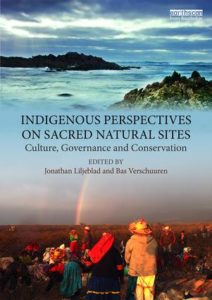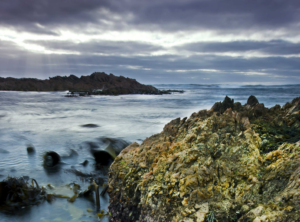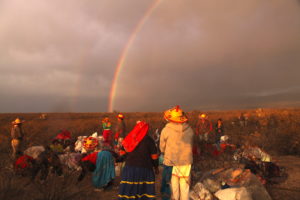
This is the featured Article of the Sacred Sites Research Newsletter Newsletter Сакавік 2019 Пытанне.
by Jonathan Liljeblad
The Rise of Indigenous Rights
Commencing in the latter part of the 20th century and continuing into the 21 вул , глабальныя намаганні набралі абароты на розных напрамках, каб прызнаць і разгледзець канцэпцыю правоў карэннага насельніцтва. Indigenous peoples are present throughout the world and their existence predates the current global system of nation-states. Each nation-state has followed its own approach towards Indigenous cultures, varying in degree between actions spanning a spectrum from reconciliation and accord to marginalization and outright extermination. The authority by which nation-states deal with Indigenous
peoples is tied to a history of European empires that in the 1648 Peace of Westphalia created a global
system based on nation-states holding sovereignty, wherein a nation-state holds exclusive control over
all population, territory, and resources within its borders.
The conceptual primacy of nation-state sovereignty served to remove Indigenous civilizations from the
global order and subjugated them to non-Indigenous power, first from colonial administration and then
later national governments. The past few decades, аднак, has hosted a range of movements to erode
the status of nation-state sovereignty. Such erosion has come both from above, in the sense of a
burgeoning growth in the number of international institutions and international treaties that brought
нацыі-дзяржава ў рамках правілаў які пашыраецца мноства міжнародных рэжымаў, якое ахоплівае мноства пытання
раёны, і знізу, у тым сэнсе, недзяржаўных грамадскіх рухаў і сацыяльных сетак працуе
транснацыянальным для прасоўвання канкрэтных прычын супраць нацыянальных дзяржаў. Сярод праблемных абласцей і прычын
быў прадметам карэнных народаў.
Much of the international attention on Indigenous peoples has centered on the question of Indigenous rights. Асабліва трэба адзначыць працу Арганізацыі Аб'яднаных Нацый (UN) institutions such as the Human Rights
Council (HRC), Office of the High Commissioner for Human Rights (OHCHR), and the Working Group on Indigenous Populations (WGIP). Their efforts led to the formation of the UN Permanent Forum on
Indigenous Issues (PFII) and articulation of Indigenous rights in international law, both through existing
human rights treaties like the International Covenant on Economic, Social, and Cultural Rights (ICESCR)
or dedicated Indigenous rights instruments like the International Labor Organization (ILO) Convention
Concerning Indigenous and Tribal Peoples (няма. 169) or the UN Declaration on the Rights of Indigenous
Peoples (DRIP). Concurrent to such broad global efforts has been more issue-specific activities such as
the World Heritage system, whose advisory bodies—the International Centre for Study of Preservation
and Restoration of Cultural Property (ICCROM), International Council on Monuments and Sites
(ICOMOS), and International Union for Conservation of Nature (МСОП)—have issued guidelines to
садзейнічаць існаванне і ажыццяўленне правоў карэнных культурнай і прыроднай спадчыны.
Патэнцыйныя праблемы ў галіне правоў карэнных народаў
Большая частка працы па правах карэнных рухаюць жаданне вырашыць спадчыны шкоды, зроблены ў мінулым для карэнных цывілізацый у рамках Вестфальскі сістэмы. хоць пахвальна, яна ўсё яшчэ недастаткова. Калі прыхаваная мэта з'яўляецца дазволам мінулага, then it is not enough to implement a rights-based system. Beyond the confines of a rights-based system, there is the larger space of worldviews spanning perspectives drawn from different values, unique experiences, and diverse ways of thinking. Such phenomena are important because they direct decisions by various peoples about how they understand life and what they want from it. In essence, they explain why people believe what they believe and why they do what they do. Такім чынам, they offer some understanding about purpose, not just with respect to the application of rights but to the manner of living that rights are supposed to protect.
The work of a rights-based system carries the risk of conflict in that an aggrieved party claims a right
either to halt a perceived aggression from another party or to force some ameliorative action from
another party, suggesting action with a tenor of antagonization. The danger of conflict only furthers the harmful legacies of the past, which pitted imperial powers and then later national governments in
antagonistic relationships with Indigenous peoples. The motivation to resolve the legacies of the past
calls for work to prevent or mitigate conflict instead of sustaining or inciting it. As a result, it is necessary to work on deeper levels to bring non-Indigenous and Indigenous perspectives together.
Finding Greater Resolution
There are examples of such kinds of work being done. Within cultural and environmental issue areas, a
мноства акцёраў працуе будаваць адносіны паміж некоренными і карэннымі кропкамі гледжання
для палягчэння сістэмы кіравання больш сайтаў, якія ажыццяўляюць культурную і экалагічную значнасць на мясцовым,
нацыянальны, і міжнародным узроўнях. Асабліва трэба адзначыць,, сістэма сусветнай спадчыны імкнецца садзейнічаць
ўцягванне карэнных суб'ектаў у працэсе прыняцця рашэнняў у дачыненні да культуры і навакольнага асяроддзя
звязаныя з карэннымі народамі, шарнірныя прынцыпы, такія як самавызначэнне, бясплатна да
інфармаваныя згоду (FPIC), and equal treatment in governance systems.
Here too, аднак, some caution should be noted. If they are to be effective in resolving the legacies of the past, the above efforts must operate to nurture relationships with social capital—that is, meaningful relationships involving trust, communication, and familiarity. This is not to suggest that there is always consensus, but rather to provide a basis for finding mutually agreeable outcomes or otherwise, at minimum, a means of finding peaceful co-existence. Building sustainable relationships calls for efforts to integrate diverse perspectives in discourse, such as encouraging Indigenous voices to be heard alongside non-Indigenous voices and, more importantly, listening to Indigenous perspectives as having value commensurate to non-Indigenous ones.

The recently published book: Indigenous Perspectives on Sacred Natural Sites: культура, Governance and Conservation, edited by: Jonathan Liljeblad and Bas Verschuuren
A reflection of the above philosophy is the book entitled Indigenous Perspectives on Sacred Natural Sites: культура, Governance and Conservation (2019, Рутледж, Jonathan Liljeblad and Bas Verschuuren, рэд.). The motivation behind the book is to facilitate self-expression by Indigenous authors about their respective approaches towards sacred natural sites. The World Heritage system has pursued an agenda in recent years in support of conservation for sacred natural sites, and the efforts have encompassed sacred natural sites of Indigenous peoples. Much of the published work, аднак, largely comes from non-Indigenous authors, і таму прыводзіць да выпадкаў некоренных экспертаў, пішучым аб карэнных культурах і ў выніку выключэння карэнных галасоў з меркаванняў іх уласнага спадчыны. Прадмет святых месцаў носіць далікатны характар, асабліва ў тых сітуацыях, калі ён займае цэнтральнае месца ў гістарычна маргінальных карэнныя культуры. У духу дазволу спадчыны мінулага і знайсці больш перспектыўны будучыню, the book seeks to place Indigenous voices alongside existing non-Indigenous work on sacred natural sites and thereby enrich considerations within this area of conservation. The authors encourage other efforts pursuing similar goals and welcome discussions on ways to do so.








